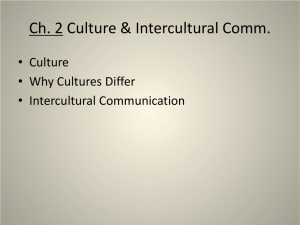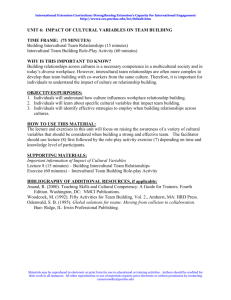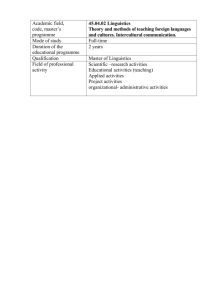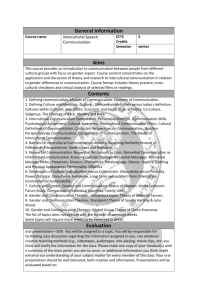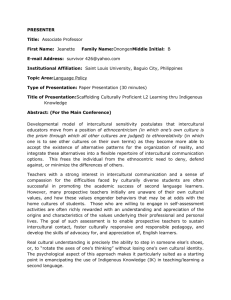What in culture?
advertisement
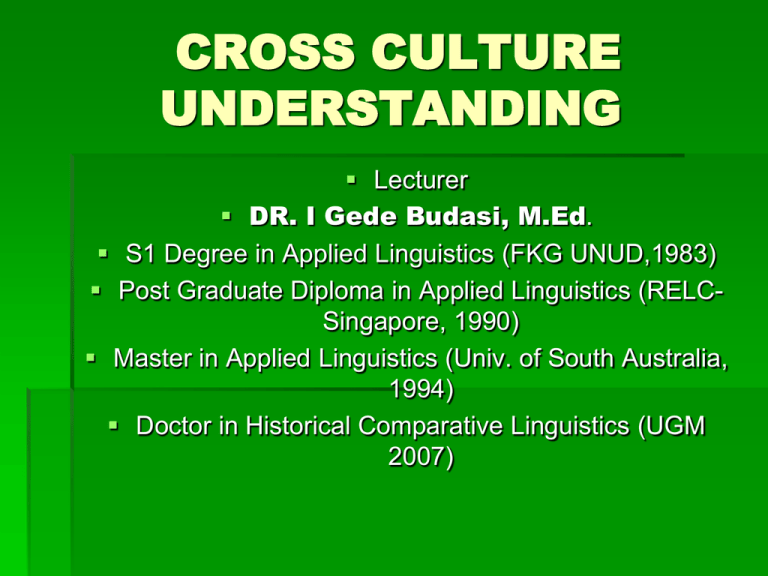
CROSS CULTURE UNDERSTANDING Lecturer DR. I Gede Budasi, M.Ed. S1 Degree in Applied Linguistics (FKG UNUD,1983) Post Graduate Diploma in Applied Linguistics (RELCSingapore, 1990) Master in Applied Linguistics (Univ. of South Australia, 1994) Doctor in Historical Comparative Linguistics (UGM 2007) Countries Visited through International Seminars on CCU Singapore, 1989 Malaysia 1990 Australia 1994 India, 1997 Newzealand, 1997 Swiss, 1997, 1998, 1999, 2012 Denmark, 2009 Russia, 2012 Future Plan for Other International Seminars on CCU Camboja 2013 Mexico 2013 Canada and America 2013 CCU SPECIFIC GOALS To encourage an appreciation of cultural diversity and the process of intercultural communication To provide a context for reading and vocabulary development To stimulate discussions about culture based on the readings and conversational activities To become a better, more tolerant person To become more skilled intercultural communication What in culture? All accepted and patterned ways of behavior of a given people. It is a body of common understanding. It is the sum total and the organization or arrangement of the group’s ways of thinking, feeling, and acting In this sense, of course, every people has a culture and no individual can live without culture. It is our culture that enables us to get through the day because we and the other people we encounter attach somewhat the same meaning to the same things (Man and Culture, Ina C Brown). Cont. Culture is that complex whole which includes knowledge, belief, art, moral. law, custom, and other capabilities acquired by member of a society ( E.B. Taylor in Kerry, 1994) The some total of ways of living built up by a group of human beings, which is transmitted from one generation to generation to another (The Macquarie Encyclopedic Dictionary) Reasons why you might be interested in developing intercultural communication skills .. For the sake of improved understanding and harmony. For the sake of doing business with one another and living together successfuly For an enjoyble and self-enriching goal. Are you motivated by all three? What is the way forward? Increase contact Goodwill Tolerance Look for knowledge, awareness and skill needed to improve intercultural communication. We all have rituals? Other cultures have customs and rituals. We don’t. Other people may follow customs and rituals. I don’t. I can do exactly what I want. My actions are independent of my culture. Quite a lot of my behaviour is retiualized. It follows a pattern prescribed by my cultural group. Cont. I don’t have total freedom of choice in my behaviour. My actions are rule-governed Accept that you are a member of a culture which regulates your behaviour What should be realized? Underneath, people are fundamentally the same Underneath, people of the world can be profoundly different Cultures are so different that we will never be able to communicate successfully. People have always succeeded and they will continue to succeed in intercultural communication. Accept cultural difference as reality Cultures are very different from one another Which do you believe? “Underneath, we are all fundamentally similar” or “We are fundamentally different” Your answer for this question is probably largely determined by your culture Are there universals of behaviour? Clearly there are universal categories of behaviour. There are five ‘panhuman cultural categories’, each with number of sub categories Categories of Behavior (Kerry, 1994) Individual Behaviour Social Behaviour Social Control and Education Technology Collective Beliefs 1. Bodily 1. Dancing 1. Marriage 1. Calendars 2. Adornment 3. Personal Names 2. Gift Giving 2. Law 2. Cooking 3. Hospitality 3. Property Rights 3. Toolmaking 2. Religious 4. Games 4. Sexual 4. Trade 5. Joking Restriction 5. Status Differentiation 6. Inheritance Rules 5. Numerals 6. Obstetrics Ritual 3. Propitiation of Supernatural Beings 7. Medicine 4. Magic 4. Gestures 5. Hair Styles 6. Mourning 6. Visiting 7. Kinship Naming 7. Education 8. Government 9. Modesty concerning natural functions 1. Dream Interpretation 5. Religious Ritual Consider the following: Great each other React to a compliment Apologise Watch TV Regard sexual behaviour Dismiss employees Interview applicant Assess their status in society Stand when talking to the boss Define friendship Make small talk Some other Concept about culture for you to consider Cultures are not fixed: change over time Culture are not Uniform: very internally No culture is an Island Intercultural Communication Model (Alo, 2003) Accommodative Communication Strategy Adaptive Effective C Culture Culture Personality A Communication B Personality Perception to Others Perception to Others Uncertainty Anxiousness CCU TOPICS OF DISCUSSION 1. 2. 3. 4. 5. 6. 7. 8. 9. 10. Introductions Verbal Patterns Nonverbal Communication Personal Relationships Family Values Educational Attitudes Work Values Time and Space Patterns Cultural Conflict Cultural Adjustment INTRODUCTIONS Varieties of Introductions Use of Titles in Introductions Eye Contact and Handshaking in Introductions Small Talk after Introductions Cultural Variations in Introductions VERBAL PATTERNS Rulers and Styles of Speaking Directness in American English Invitations Speaking and Refraining from Speaking Different Ways of Expressing Common Needs NONVERBAL COMMUNICATION Cultural Differences in Nonverbal Communication Gestures Facial Expressions Eye Contact Space PERSONAL RELATIONSHIPS Circles of Friends Mobility and Friendship Instant Friendships Male – Female Relationships Intercultural Friendships FAMILY VALUES Child Raising Young Adulthood The Elderly The Nuclear and the Extended Family Familial Roles Stability and Change in the Family EDUCATIONAL ATTITUDES Diversity in Education Active Participation The Teacher – Student Relationship Independent Learning The Honor System Competition WORK VALUES The “Work Ethic” The “American Dream” Rewards and Job Satisfaction Workaholics Leisure and Socializing TIME AND SPACE PATTERNS Time Promptness Division of Time Future Time Architectural Differences Privacy and the Use of Space CULTURAL CONFLICT Communication and Culture Misinterpretations Ethnocentrism Stereotypes and Prejudice CULTURAL ADJUSTMENT Culture Shock The Adjustment Process The Re-entry Process Individual Reactions References Alo L. 2003. Dasar-Dasar Komunikasi Antarbudaya. Jakarta: Pustaka Pelajar. Deena R Levina & Mara B Adelman. Intercultural Communication for English as a Second Language: Beyond Language. New Jersey: Prentice-Hall,Inc., Englewood Cliffs Kerry O’Sullivan 1994. Understanding Ways: Communicating Between Cultures. Sydney: Hale & Iremonger Pty Limited.
